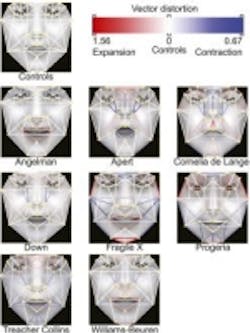Computer vision algorithms help identify genetic disorders from ordinary photos
Researchers from Oxford University have developed a computer vision and machine learning-based algorithm that analyzes family photos and helps physicians diagnose rare genetic disorders.
Genetic disorders affect almost 8% of all people, about a third of whom will have symptoms that greatly reduce their quality of life. While there are more than 7,000 known inherited disorders, only a small minority of patients with a suspected developmental disorder receive a diagnosis, according to the research paper published in eLIFE.As a result, researchers from Oxford University developed an automated approach that incorporates recent computer vision advancements into an algorithm designed to “extract phenotypic information from ordinary non-clinical photographs and, using machine learning, models human facial dysmorphisms in a multidimensional 'Clinical Face Phenotype Space.'”
The algorithm is trained for automatic annotation of 36 feature points of interest across the face. The approach utilizes a variety of facial detection algorithms and custom learning to accurately place feature points on a given face and accounts for variations in lighting, image quality, background, pose, facial expression, and identity. It builds a description of the face structure by identifying corners of eyes, nose, mouth, and other features, and compares it against a database of patient photos.
MORE ARTICLES
Academic researchers developing new activity recognition algorithm
Imaging software targets scientific applications
Industrial Automation : Shape from shading images steering components
The algorithm then identifies patients sharing the same condition and automatically clusters them together. Across all images in the database the researchers used, manual checking found that the algorithm detected and annotated 99.5% of tested faces correctly with accuracies in the 6-60% range of the width of an eye.
As the computer algorithm acquires more data via photos of patients with a particular syndrome, it does a better job at suggested a potential diagnosis for a photo. In addition, patients will also cluster together in situations where no documented diagnoses exist, potentially helping in identifying rare genetic disorders.
"A doctor should in [the]future, anywhere in the world, be able to take a smartphone picture of a patient and run the computer analysis to quickly find out which genetic disorder the person might have," said Dr Christoffer Nellåker of the MRC Functional Genomics Unit at the University of Oxford in the press release.
He added, "This objective approach could help narrow the possible diagnoses, make comparisons easier and allow doctors to come to a conclusion with more certainty."
View the press release.
Share your vision-related news by contacting James Carroll, Senior Web Editor, Vision Systems Design
To receive news like this in your inbox, click here.
Join our LinkedIn group | Like us on Facebook | Follow us on Twitter | Check us out on Google +
About the Author

James Carroll
Former VSD Editor James Carroll joined the team 2013. Carroll covered machine vision and imaging from numerous angles, including application stories, industry news, market updates, and new products. In addition to writing and editing articles, Carroll managed the Innovators Awards program and webcasts.
